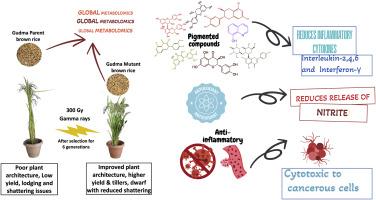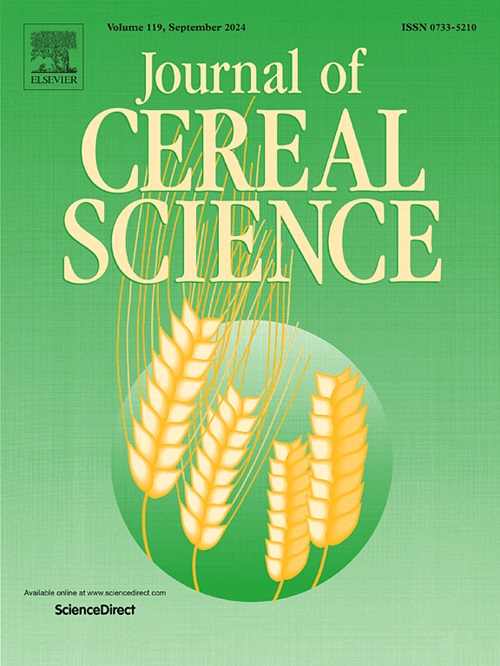A metabolomics-guided mutation breeding approach for enhancing agronomic traits and preserving phytochemical properties in gudma pigmented rice
IF 3.7
2区 农林科学
Q2 FOOD SCIENCE & TECHNOLOGY
引用次数: 0
Abstract
Rice, a staple food worldwide, is rich in beneficial plant compounds. Traditional rice varieties, prioritized for their nutritional and medicinal qualities, are often neglected because of their low yield and other poor agronomic traits. In this study, mutation breeding was used to enhance the agronomic traits of Gudma Dhan, a dark-red Indian traditional rice variety. Radiation-induced mutation breeding improved agro-morphological characteristics by increasing grain yield, productive tillers, and spikelet fertility (%), while reducing plant height and maturity duration. Metabolomic analysis of Gudma Dhan and its mutants revealed an abundance of flavonoids, such as Cianidanol, Catechin, Taxifolin, and 2,3-cis-oligoproanthocyanidin, along with other bioactive compounds. The phenylalanine pathway was over-enriched in the Gudma Dhan parent and its mutant, implying that flavonoid production is higher in pigmented rice genotypes than in non pigmented rice. The methanolic brown rice extract (BRE) of Gudma Dhan exhibited potent antioxidant properties in cell-free and cellular systems. BRE inhibited the secretion of IL-2, IL-4, IL-6, and IFN-γ by lymphocytes and the secretion of nitric oxide, IL-1β, TNF-α, and IL-6 by macrophages, indicating its anti-inflammatory activity. The mutant variety successfully preserved the bioactivity of the parent, indicating that mutation breeding did not compromise the metabolic profile. Thus, global metabolomics can help in accelerating the selection of mutants with desired properties without the need of wet lab experiments.

代谢组学指导下提高古玛色素水稻农艺性状和保持植物化学特性的突变育种方法
大米是世界范围内的主食,富含有益的植物化合物。传统水稻品种因其营养和药用品质而受到重视,但由于产量低和其他农艺性状差而经常被忽视。本研究采用诱变育种的方法,提高了印度深红色传统水稻品种古玛丹的农艺性状。辐射诱变育种通过提高籽粒产量、有效分蘖数和小穗育性(%)来改善农业形态特征,同时降低植株高度和成熟期。对古玛丹及其突变体的代谢组学分析显示,古玛丹含有丰富的黄酮类化合物,如Cianidanol、儿茶素、Taxifolin和2,3-顺式低聚原花青素,以及其他生物活性化合物。Gudma Dhan亲本及其突变体的苯丙氨酸通路过度富集,这表明色素水稻基因型的类黄酮产量高于非色素水稻基因型。古丹甲醇糙米提取物(BRE)在细胞和无细胞系统中表现出强大的抗氧化性能。BRE抑制淋巴细胞分泌IL-2、IL-4、IL-6和IFN-γ,抑制巨噬细胞分泌一氧化氮、IL-1β、TNF-α和IL-6,显示其抗炎活性。突变品种成功地保留了亲本的生物活性,表明突变育种没有损害代谢谱。因此,全球代谢组学可以帮助加速选择具有所需特性的突变体,而无需湿实验室实验。
本文章由计算机程序翻译,如有差异,请以英文原文为准。
求助全文
约1分钟内获得全文
求助全文
来源期刊

Journal of Cereal Science
工程技术-食品科技
CiteScore
7.80
自引率
2.60%
发文量
163
审稿时长
38 days
期刊介绍:
The Journal of Cereal Science was established in 1983 to provide an International forum for the publication of original research papers of high standing covering all aspects of cereal science related to the functional and nutritional quality of cereal grains (true cereals - members of the Poaceae family and starchy pseudocereals - members of the Amaranthaceae, Chenopodiaceae and Polygonaceae families) and their products, in relation to the cereals used. The journal also publishes concise and critical review articles appraising the status and future directions of specific areas of cereal science and short communications that present news of important advances in research. The journal aims at topicality and at providing comprehensive coverage of progress in the field.
 求助内容:
求助内容: 应助结果提醒方式:
应助结果提醒方式:


